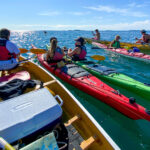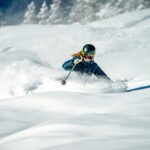 It was a magical January day with Mica Heli Guides high in the Rocky Mountains northeast of Revelstoke. We were pausing between huge pitches to gaze at the mountains ringing us. Someone pointed out a hanging glacier clinging to an enormous mountainside, its toe cleaved into translucent blue seracs that periodically crack and tumble down to the cliff below. At this, our guide began lamenting the rapid retreat of glaciers all over the Rocky Mountains. Some that he visits regularly show only scraped rock and rubble for hundreds of metres where blue ice once reigned. If global warming goes on, he wondered, would there be any glaciers left on which to ski and hike? The others nodded their heads and murmured assent.
It was a magical January day with Mica Heli Guides high in the Rocky Mountains northeast of Revelstoke. We were pausing between huge pitches to gaze at the mountains ringing us. Someone pointed out a hanging glacier clinging to an enormous mountainside, its toe cleaved into translucent blue seracs that periodically crack and tumble down to the cliff below. At this, our guide began lamenting the rapid retreat of glaciers all over the Rocky Mountains. Some that he visits regularly show only scraped rock and rubble for hundreds of metres where blue ice once reigned. If global warming goes on, he wondered, would there be any glaciers left on which to ski and hike? The others nodded their heads and murmured assent.
Somehow I found this anguish incongruous amid our astounding skiing. “Bob,” I replied, “you fellows have been boasting for weeks about your all-time record snowfall, giving you the best season you’ve ever had. It’s taking you forever to do snow profiles—because you have to dig down four metres. The skiing is simply amazing. What difference does it really make if the transition from light, lovely powder over blue ice to fluffy powder over rock moves 100 metres this way or that compared to 30 years ago?
“And speaking of 30 years ago, I do remember much colder winters when I was a kid. But do you really want to go there? It’d be -40 up here for ?ve weeks on end. Nobody could stand skiing. There might not even be a viable business called Mica Heli Guides. If global warming means endless powder, -5 temps in mid-January and long seasons, let’s have it.”
I could have added that if we’re all so worried about global warming, the first measure should be to prohibit heli-skiing. It’s hard to imagine a more frivolous motive for emitting thousands of tons of carbon dioxide. Personally, I’m relaxed about it all. What bugs me is the weird oblivious hypocrisy of those who claim that global warming keeps them up at night while believing we can rejig the world’s climate to our liking just by screwing in a few compact ?uorescent bulbs and taking shorter showers.
Anything short of a multi-volume treatise on this emotionally overwrought topic risks apoplectic letters pointing out this or that empirical gap, overlooked pronouncement by the guru-du-jour, omitted scienti?c paper or unacknowledged international conference communiqué. So let’s start with what this story isn’t about. It’s not about whether Canada should adopt, ignore or repudiate the Kyoto Protocol. It’s not about whether global warming is happening or what its effects might be. It’s about preserving your right to keep making your own personal observations, to think for yourself amid the staggering political pressure to conform to the accepted dogma of global warming alarmism.
Nowadays, independent thinking is more important than ever. Just in August NASA’s Goddard Center for Space Studies had to perform a major climb-down from its years-old claim that the 1990s were the hottest decade and 1998 the scorchingest year “on record” (that is, since 1880, a geological eyeblink). Its computer software was out of synch, somehow. It turns out the hottest year of the past 140 was way back in 1934, and the Dirty ’30s are the worstoffending decade, warmness-wise, scoring four of the top-temp years on record. The ’90s were warm, but the ominous upward trend is erased, replaced by two plateaus 80 years apart. The ’30s, you’ll recall, came before the rise of man-emitted carbon dioxide, so that instance of “global warming” at least had to be natural. Every global warm-monger ought to be feeling distinctly queasy, since the hottest-decade-ever claim was a central part of the propaganda effort. Now demolished.
And to those who inevitably write in to the editor to say I’m an untrained oaf with no business writing about anything so exalted as global warming, I’d be happy to trade my silence for that of Al Gore or David Suzuki. Neither of them has any training in climate science. Each consumes many times the energy of the average Canadian—the multimillionaire Gore with a 200,000-kilowatthour- per-year Tennessee mansion (20 times the average U.S. family’s power consumption) and a pool-house that burns $500 per month in natural gas; Suzuki with his diesel-belching propagandamobile and, notwithstanding his railing about overpopulation, his impressive brood of offspring.
That global warming believers attempt to silence their opponents through bullying, insults and fear-mongering shows what a uniquely twisted topic this has become. We’re allowed opinions on the war in Afghanistan, taxes, euthanasia or “safe” drug injection sites. Disagreement on these and innumerable other topics is the stuff of democracy. So why not global warming?
Much of what you see and read in the news media consists of generalized claims repeated like an incantation plus selfserving anecdotes—you know, stories about receding Antarctic ice, stranded polar bears or vanishing winters. Many of these are false or exaggerated—including the infamous polar bears on the ice ?oe. In any case, if the global warming alarmists can use unrepresentative out-of-context instances to argue there’s a worldwide trend, then we mere skiers should, at minimum, be allowed to think over the implications of actual facts we observe out on the mountain.
Last season there was no shortage of intriguing facts. There was the aforementioned, all-time-record snowpack at Mica. There were near-daily press releases about Whistler’s successive records. By April 5, Whistler had received 1,301 cm of snow. I showed up on April 18 to winter snow on all northerly aspects. On the 21st I went touring and skied three big north-facing powder runs. On the 23rd I could still ski into the village.
With its low elevation and coastal climate, Whistler should be the ski industry’s proverbial canary in the coal mine. Its average winter freezing elevation is so precariously balanced that even a half-degree rise in average temperature should have substantial effects. Whistler should be among the ? rst Canadian ski resorts to succumb to the baleful effects of even a little bit of global warming.
For years global warming believers have relied on a worldwide temperature study that purported to show nearly stable temperatures for centuries, followed by a steep and continuing rise in the past few decades. Due to its shape, this has become known as the “hockey stick” graph. If it’s correct, pretty much every year should be warmer than the one before. For resorts like Whistler, conditions should be worsening fairly steadily. Instead, last year Whistler was both bounteously snowy and relatively cool. And this wasn’t a bizarre outlier—Whistler continues to rack up epic, terrible and in-between seasons in roughly equal measure. If Whistler’s okay, I’m not worried about higher-lying resorts like Kicking Horse or Lake Louise.
By contrast, last season the European Alps had an absolute wipeout. It was probably the worst winter for skiing since the Second World War, with green grass in the alpine at Christmas, virtually no snow during mid-winter and temps of +20 by early April. Naturellement, the Euros streamed to North America. The point being, they had somewhere to go—an odd occurrence amid “global” warming.
And how quickly everyone forgets that the previous season was chock full of snow and coldness. The season before that was Europe’s coldest winter in 60 years. Cities in central Germany that don’t own a snowplough were buried for weeks. When I ? ew into Switzerland that March, I could have gone ski touring in the hills around the city of Zurich. The Alps’ peaks were at -20 and we virtually drowned in cold, light, Canadian-style powder.
Maybe the climate is changing—back to how it was when I was a kid. Last season in the Alberta Rockies was reminiscent of those long, snowy winters of the early ’70s. We had the best conditions in 10-15 years—the snowpack formed early and stayed. I skied powder right off the lifts at Lake Louise every Sunday in December. We also had a great middle—it snowed every day at Kicking Horse for the first two weeks of March, rendering the conditions sublime and the resort’s marketing department insufferably smug. And then we had…a strong finish! In early April it snowed daily for a week in downtown Calgary. Then we had two big blizzards in May.
Look, I don’t read all that much into individual instances of weather, other than the modest proposition that it isn’t exactly suggestive of the remorseless march of a single planet-threatening trend. According to the hockey stick graph, we ought to be seeing a virtually linear increase in temperatures nearly everywhere (except for the occasional outlier): warmer every year, drier every year, less snow every year, shorter ski seasons every year. But we aren’t. The weather is all over the place, as it’s always been. Perhaps others have also noticed this, and perhaps it’s why the alarmists have shifted their key term from “global warming” to “climate change.” It’s a wonderful formulation: innately self-serving under all conditions. Literally any weather, anywhere, can be presented as bad and a consequence of humankind’s misbehaviour. And that’s exactly what the propagandists do.
Last fall, when Eastern Canada was enjoying its shorts-and-shirtsleeves weather without apparent end, the media ran virtually daily stories about the dank, dark puddle that Ottawa’s Rideau Canal had become. The imminent “Green Christmas” was presented— over and over—as proof of global warming. The skiing out West was already epic—but the news media buried it under an avalanche of Vancouver ?ood disaster stories.
So when winter descended upon the East with a vengeance—merely a little later than normal— the activists and their journalistic fellow travellers seamlessly switched rhetorical gears. Falling back on the new all-purpose idea of climate change, they talked up the day’s weather as proof that SUV emissions were making the climate “wackier” and “less predictable.” The contradiction was simply no problem for them. Climate change fear-mongers routinely predict worsening storms and any other baleful effects they can think of, only to fall silent when the temporary phenomenon abates or when the anticipated event fails to show.
Contrary to the overheated claims from Canada’s multi-hued political bandwagon demanding we “address” climate change, the basic science underlying the theory remains surprisingly weak. I’d hoped to grub up a few modest examples from the presumably meagre literature of global warming skeptics. In fact, even casual research reveals an avalanche of information from credible sources that dismembers virtually every facet of global warming theory, especially its predictions of doom. Merely summarizing it would take a substantial book.
So instead, a few juicy morsels for you to mull over and, if you’re so inclined, ?le away for future discussion:
- Hans von Storch, one of the world’s top climatologists and a lead author of the Third Assessment Report of the Intergovernmental Panel on Climate Change (IPCC), considers predictions of “climate catastrophe” to be “completely idiotic and dubious,” “hysterical sermons” created by “priests.” Storch, who doesn’t doubt the world is getting warmer, only whether this will be bad, has documented the tendency of people throughout history to conjure outlandish extrapolations of climatological doom out of transient weather events.
- Dr. William Gray, one of the world’s top hurricane forecasters, calls Al Gore “a gross alarmist” who “doesn’t know what he’s talking about.”
- About concerns that the world’s major ice caps are melting, a routine claim by global warming alarmists and a trend that if true is suggestively worrisome to skiers, here’s Dr. R.M. Carter, professor in the marine geophysical laboratory at James Cook University in Australia: “Both the Antarctic and Greenland ice caps are thickening. The temperature at the South Pole has declined by more than one degree Celsius since 1950. And the area of sea ice around the continent has increased over the last 20 years.” over the last 20 years.”
- Even The New York Times, America’s most reliable voice of liberal politics, in March ran a story quoting a bunch of scientists decrying Gore’s “alarmism.” Don Easterbrook, professor emeritus of geology at Western Washington University, said the flick contains “a lot of inaccuracies…and we have to temper that with real data.”
- While the press-released summaries and media spin by the IPCC become more and more shrill with each report issued, the empirical data and consensus predictions in its actual reports have been de?ating: less increase of temperature, reduced sea level rise (as little as eight cm), less than previously thought human contribution to atmospheric carbon dioxide increases and so on. Perhaps the inverse relationship between PR claims and hard data is no coincidence. Incidentally, this collection of governmentfunded scientists should itself be viewed with suspicion. Frederick Seitz, the former head of the National Academy of Sciences in the U.S., has written that, “I have never witnessed a more disturbing corruption of the peer-review process than the events that led to [the 1996] IPCC report.”
That’s a tiny sampling of what’s available. Still, the facts have had a rough go recently in the face of the media-entertainmentgovernment juggernaut barrelling alongside Al Gore’s An Inconvenient Truth. If you’re even the least bit skeptical of this cavalcade of credulity, or at least open to a balancing view, check out the Great Global Warming Swindle. This documentary is hard to purchase since nobody wants to distribute it yet, but you can ?nd it on You Tube.
In the end, whatever anyone might claim, nobody really knows what would happen if Canada got warmer. Many predict we’d be drought-ridden. Would we? Remember, we’re talking about global warming. More overall heat has to mean more evaporation over the oceans. That airborne moisture has gotta come down somewhere. Why shouldn’t it be onto freshly planted Prairie ?elds or ski resort slopes in mid-November? I don’t pretend to know this would occur—but neither can the predictors of catastrophic droughts and plagues of locusts. We know for sure that Canada is much warmer than in the ice ages of prehistory and somewhat warmer than in the Little Ice Age of the 1400s- 1700s—and that this is good. Would it be so bad if Canada got a little bit warmer still? For one thing, our carbon dioxide emissions would go down since we would use less energy for heating.
I have little doubt that human ingenuity could amply overcome the potential disruptions of a somewhat warmer Canada. But of the various scenarios—including the dubious claim that even a wee bit of warming would be disastrous—the one outcome we know would be calamitous would be another Ice Age. Having nearly our entire country covered in a milethick sheet of ice—as we know has occurred numerous times—would be simply unsurvivable as a civilization.
Canada as we know it would be wiped out. There’d be nothing left except a few polar research stations, some narwhal-hunting Inuit paddling around what used to be Vancouver and Halifax harbours, and a couple teams of Mexican archaeologists picking at the mummified remains of freeze-dried soccer moms still clutching the minivan steering wheel. Survivors would end as huddled refugees in camps in Oregon, Nebraska or Ohio, or perhaps as “undocumented workers” grubbing potatoes in the newly chilly San Joaquin valley. Compared to that scenario, figuring out how to ski on smaller glaciers, survive shorter winters or relocate a few ski resort base areas partway up the mountain is as nothing.
More Koch here.



